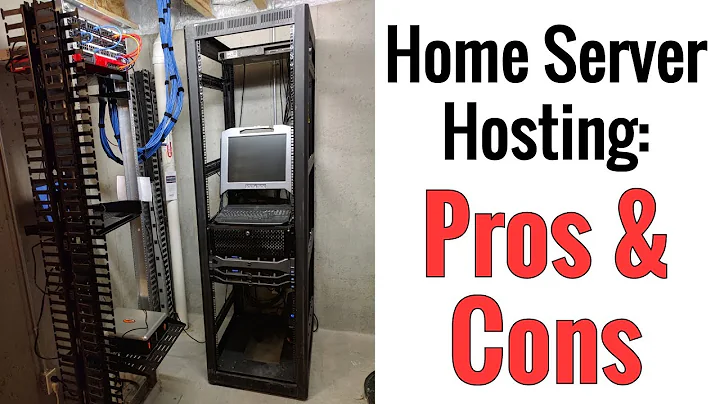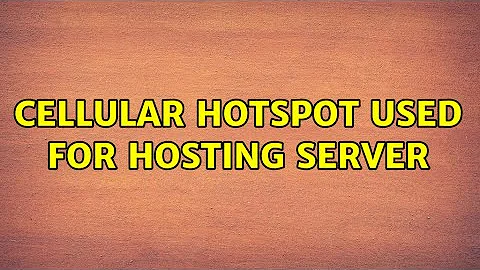Cellular hotspot used for hosting server
Solution 1
Most mobile IPv4 service is behind ISP level NAT. So you can't accept incoming connections.
One option may be using a different provider. With some searching you may find a boutique provider who can offer public IPv4 on a cellular connection in your area. For example in the UK Andrews and Arnold offer this service.
Another option if your provider offers it and your stuff supports it may be IPv6. T-Mobile in the USA certainly offer public IPv6 addresses to their handsets though I don't know how that interacts with mobile internet routers/tethering.
The final option is to use a VPN like Daniel suggests.
Solution 2
Mobile broadband has been using Carrier-grade NAT before that term was even coined, so it’s not suitable for hosting anything. There may be business services with non-NAT access, at additional cost, of course.
Most Internet access methods are based on “dial-up”: You start a session, authenticating yourself. Of course, if you have a fixed line, this session is likely to exist much longer, because it won’t be interrupted by signal loss or whatever. Still, mobile broadband is essentially the same.
So, I’ll just decide your question is “How do I make this work?”. What you want is a static anchor that both the client (where you access the videos) and the DVR are connected to. This way, it doesn’t matter where (in terms of Internet access) both client and DVR are.
One possibility to accomplish this is to rent a VPS and install a VPN server on it. You would then use a VPN client both in your DVR’s network and on the client machine. This tunnels through all NAT and firewalls on the way.
This setup has an additional benefit: The DVR is not exposed to the Internet. The security of the DVR’s web service is questionable. If possible, it should not be exposed to the Internet.
An alternative to renting a VPS would be to use something like Hamachi.
Both solutions might require an additional machine that acts as a VPN client in the DVR’s network. A Raspberry Pi should be enough, but you need to check the compatibility of the VPN software first!
Solution 3
it is very likly that that the mobile provider is actually blocking those ports.
After checking it with the mobile provider you can try connecting a regular computer to the same modem and use some basic http server to see if its works. Also on a regular computer you can also use stuff like ngrok/localtunnel which usually (assuming they work thorugh mobile connection and are not blocked) can be used through NAT and Firewalls.
Related videos on Youtube
Jacob Valdez
Updated on September 18, 2022Comments
-
 Jacob Valdez over 1 year
Jacob Valdez over 1 yearWe would like to use this mobile hotspot to connect a video security system (Apasonic DVR) to the internet.
The Apasonic DVR hosts a web page where security footage can be accessed. With a wired broadband internet connection, it's been easy to set up port forwarding and login to the DVR remotely.
Remote login has not been possible with this mobile hotspot, nor can the hotspot even be pinged. The mobile hotspot has port forwarding configuration but this has been of no use.
I suspect that a wireless hotspot in unsuitable for hosting a server. My guess is that the cellular network is optimized for short-lived connections that use a lot of bandwidth, and that long-lived connections that use little bandwidth are the "worst enemy" of the cellular company because data usage is paid for, not time connected.
Cellular internet seems to have different capabilities than broadband, and I'd be very interested to see more documentation of this. Perhaps it is grounded in the 7-layer networking model. This question isn't particular to this particular hotspot device or the security system we are using. I've heard that cellular internet is similar to dial-up, in that the device does not maintain a constant connection and must initiate a short-lived connection. Obviously dial-up is not suitable for hosting a server that can receive a connection at any time, because the connection is broken most of the time. Do cellular internet, broadband, dial-up, and DSL, occupy the same layer of that 7-layer model?
Back to the ping attempt -- that test does not prove much because a modem cannot generally be pinged, as it is configured by default. A server behind the modem is more likely to respond to a ping. I think I've seen a modem configuration option that allows the modem to respond to a ping.
The IP address of the cellular hotspot may be changing frequently or infrequently -- I am not sure. Let's assume I'm not making the obvious mistake of trying to access a server at the wrong IP address. Can a cellular hotspot host a server?
In summary, the articles I've found about this question seem to be more concerned with port forwarding and firewalls than answering a fundamental question about the capabilities of a cellular hotspot.
Thank you!
EDIT
Hi. My name is John Becich and I'm Peter's Dad. Peter tried to help me after I retired for the night, and he got a couple points wrong when I was not there to check his understanding of my project. We appreciate your answers to the question: Can anyone use a hotspot (inside warehouse) as a target, for remotely-initiated internet access (to a warehouse surveillance system).
Please consider the following refinements to my son's noble attempt to help his father:
Point#1. For years, I have easily remotely accessed the subject (geographically-distant) video surveillance DVR, by hard-wired internet connection. That means the warehouse where the DVR exists has been continually equipped with Charter cable internet service (until recently). I configured router and Cat5 wiring in the warehouse; I install port forwarding in the router and thereby easily punched through NAT protection in said router, from WAN side to LAN side; that's what port forwarding does so well. Meanwhile, the DVR could initiate outbound transmission of e-mails. So initiation of internet communication was bi-directional and independent. Admittedly, the warehouse had "always on" internet; aka "broadband, wired" internet; ... and the IP address for the warehouse rarely changed, even though Charter (the ISP) assigned said IP dynamically.
Point#2 I have recently experimented with two different hotspots and their related wireless networks (aka "cellphone service providers"), in the attempt to REPLACE dependency on terrestrial cable internet, at the warehouse. I have succeeded using either service provider, to the extent that the DVR can send out e-mails. But I have failed using either service provider, to initiate remote inspection of the DVR from afar. In other words, DVR succeeds in accessing my remote location by e-mail; and the IP at the warehouse sticks; but I haven't gained reverse-direction access to my warehouse DVR system.
Point#3 Both wireless service providers employ GSM (as opposed to CDMA) networks. Indeed, one network will ping, while the other will not. Peter overlooked this "ability to ping."
Point#4 Provider#1 is FreedomPop/Sprint ... with hotspot by ZTE MF975S. This network won't ping, ever, and that, IMHO, terminates its candidacy as my long-term service provider. The MF975S has provision for port forwarding, and I'm not sure whether it works or not.
Point#5. Service Provider #2 is ConsumerCellular/AT&T. Indeed, this provider's network pings (across vast distances) every time. The Consumer-Cellular-provided hotspot is a ZTE Z289L and it has provision for network port forwarding, which I gleefully populated. But the hotspot won't forward ports, and appears to therefore be defective. (Reviews on Amazon are also poor, for this device.) I am presently shopping for a GSM-oriented hotspot that replaces the Z289L, and if it forwards ports (by experimental observation), I expect to succeed in the ultimate goal: to inspect my surveillance cameras, via hotspot @ warehouse, from afar (using desktop computer as "viewer"). Yes, I can introduce some other hotspot to Consumer Cellular's service.
Point#6. My son, Peter, is skeptical of my experiment and suspects there is structural impossibility at play, regarding anyone's attempt to remotely log into a site, when said site's only internet connection is via hotspot. I have told my son that, years ago, I succeeded in such experiment, using a friend's hotspot (that was, ironically, branded "Coldspot"!) All that hardware is long gone, and impossible to repeat.
Point#7. That friend remains, however, and he uses a CDMA hotspot today, provided by Verizon. I expect to experiment with that.
Point#8. T-Mobile resembles Consumer Cellular and Sprint in that it seems to have a network built on GSM, rather than CDMA. An experiment using a T-Mobile smartphone as a hotspot yielded a "no ping" experimental result, so I am not pursuing T-Mobile as a candidate hotspot provider for my warehouse.
-
Thalys over 7 yearsdoes your telephone company us CGN?
-
 Jacob Valdez over 7 yearsThanks for your quick response @JourneymanGeek . I don't know. Consumer Cellular simply buys network capacity from AT&T, so we'll have to answer that question through the AT&T probably. We will learn about this (en.wikipedia.org/wiki/Carrier-grade_NAT) and answer the question. Thanks
Jacob Valdez over 7 yearsThanks for your quick response @JourneymanGeek . I don't know. Consumer Cellular simply buys network capacity from AT&T, so we'll have to answer that question through the AT&T probably. We will learn about this (en.wikipedia.org/wiki/Carrier-grade_NAT) and answer the question. Thanks -
Thalys over 7 yearscheck your ip address. compare it against the RFC 1918 and RFC6598 ranges en.wikipedia.org/wiki/Private_network . You might also have the standard web server port closed
-
Daniel B over 7 yearsAn idle connection is most certainly not “the worst enemy” but normal. Phones are connected all the time.
-
 StockB over 7 yearsEven if you your carrier isn't using CGN, they may have port filtering on a firewall.
StockB over 7 yearsEven if you your carrier isn't using CGN, they may have port filtering on a firewall.
-
-
v7d8dpo4 over 7 yearsRelated superuser.com/questions/121435/…






